IN THIS ISSUE
- Whigham won't use wild snakes
- Capt. recounts 2021 whale collision
- Breeding breakthrough for rare sallies
- Terry Johnson on planting pineapple sage
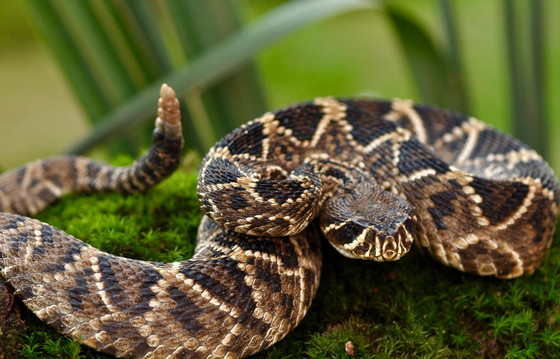 Eastern diamondback rattlesnake (Mark Krist)
While the name remains the same, this year’s Whigham Rattlesnake Roundup features a significant change that will benefit the southwest Georgia community and wildlife conservation.
The event set for March 5 in the small Grady County town will not include wild-caught rattlesnakes or products made from rattlers, a first since its start in 1960. Whigham had been the last rattler roundup in Georgia, after Claxton’s Rattlesnake and Wildlife Festival made a similar move 10 years ago.
Wildlife organizations welcomed Whigham’s announcement. Roundups have contributed to the decline of rattlesnakes such as the eastern diamondback, the largest rattler species. Habitats and other animals also have been harmed by the now illegal practice of gassing gopher tortoise burrows to collect snakes.
For the Whigham Community Club, however, the driving concern was “still being viable so we are able to give to the community,” past president Greg Ponder said. The 72-year-old club uses the money raised to meet local needs, from supporting Boy Scouts and Whigham school trips, facilities and sports teams to helping sponsor county livestock shows and answer other community requests.
While COVID cancelled the 2021 event, in recent years the number of rattlesnakes had dwindled. The problem: fewer snake hunters and rattlers, Ponder said. Yet to draw a crowd, he added, “we must have snakes.”
With help from Chehaw, Southeastern Reptile Rescue and DNR, the club will this year. The provision of rattlers and other native snakes will underpin an educational focus on the reptiles and the ecological roles they fill.
DNR senior wildlife biologist Daniel Sollenberger is thrilled about the change in the event, calling it a plus for snake conservation. “We are happy to be able to participate with the Whigham Community Club this year and show our support for another pro-wildlife conservation festival in Georgia.”
Ponder said the support is appreciated. The club’s hopes for what is promoted on Facebook as a no-kill event include a large crowd and a bright future. “We’re working to keep this thing going.”
PLANNING TO GO
- When: 8 a.m.-4 p.m. March 5
- Where: Whigham Community Club Rattlesnake Roundup Grounds, Highway 84 East, Whigham
- Admission: $5 per person; $20 max per family
- Attractions include snake demonstrations, wildlife exhibits, food vendors, arts and crafts, a petting zoo, pony rides, live music
NEXT UP: CLAXTON FEST
Snake fans can experience two rattlesnake-powered traditions back-to-back, with the 54th annual Claxton Rattlesnake & Wildlife Festival scheduled for March 12-13, the weekend after the Whigham Roundup.
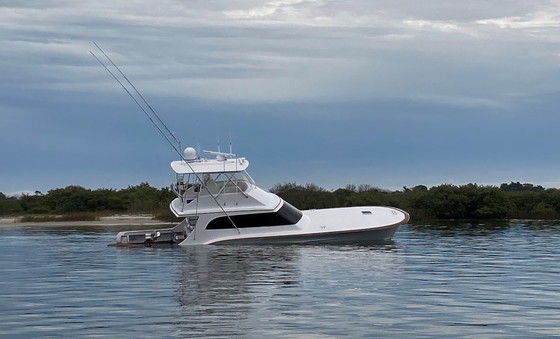 The About Time the day after (Mike Alyea/courtesy of Florida FWC)
"I knew if I didn’t get that port-side motor going
and us moving, we were going to sink."
Capt. Shane Ryan had spent a lifetime boating and fishing off the Florida coast. But in all his years, he never had a moving boat stopped dead in the water.
And a 54-foot sportfisher topping 20 knots? “I didn’t think it was possible,” Ryan said.
Just over a year ago, at nightfall on Feb. 12, 2021, the impossible happened when the million-dollar boat he was driving hit a North Atlantic right whale calf and its mother a half-mile out of Florida's St. Augustine inlet.
The collision would prove tragic for the whales and the boat.
It would also intensify efforts to inform boaters about right whales and ways to help avoid them. ...
Read Capt. Ryan’s account and precautions for coastal boaters.
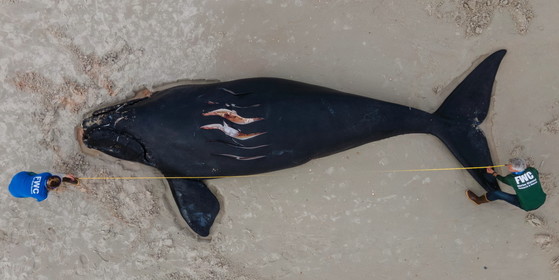 Florida officials measure the calf killed in the collision. (Tucker Joenz/Florida FWC, taken under NOAA permit 18786)
RIGHT WHALE UPDATES
-
The calf count for the endangered whales reached 14 this winter with adult no. 3157 and her calf spotted off Cumberland Island. Meet the moms.
-
Right whales aren’t bearing enough calves to offset deaths from fishing rope entanglements and vessel strikes. The imperiled species has declined from an estimated 480 whales in 2011 to fewer than 350 today.
-
Read the latest on Snow Cone, the mom still trailing fishing rope but seen with a new calf in December.
-
Monterey Bay Aquarium Seafood Watch has posted draft assessments of fisheries that pose risks to the survival of right whales, including “red-listing” American lobster, Jonah crab and other trap, pot and gillnet fisheries as seafood and sources to avoid. Comments are due by Feb. 28.
-
NOAA Fisheries offers fascinating facts about right whales each Wednesday on Facebook and Instagram.
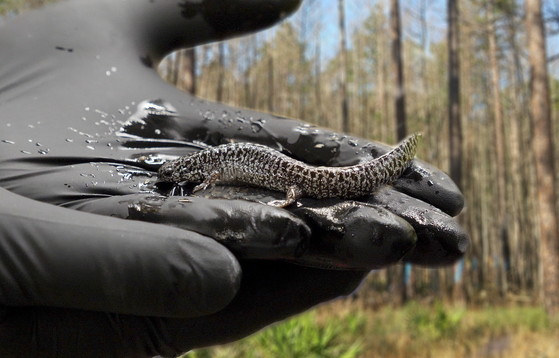 Frosted flatwoods salamander in the field (Mark Mandica/Amphibian Foundation)
There’s new hope for frosted flatwoods salamanders following word from the Amphibian Foundation that it has bred the endangered species in captivity for the first time.
For nearly a decade, the Atlanta conservation nonprofit has worked on a captive breeding process to protect frosted flatwoods salamanders. These amphibians, beautifully mottled in gray, silver and black, have declined by 90 percent since 2000 and are now known from only three populations, one in Georgia and two in Florida.
The loss of the longleaf pine savannas the salamanders evolved with, as well as diminishing seasonal rains needed to fill the temporary pools their eggs hatch in, have pushed them to the brink of extinction.
Leading an effort to protect them in captivity, Amphibian Foundation established breeding groups in 2017 and – overcoming obstacles to propagating the secretive animals – celebrated its first eggs in December.
The goal is to produce offspring that can be released into managed habitats and thrive in the wild. The breeding protocol can also be replicated by others, speeding up recovery, said foundation co-founder and Executive Director Mark Mandica.
“This conservation accomplishment is a thrilling moment of scientific achievement for our team, partners and these special salamanders,” Mandica said.
Project details, including what partners had to say. Plus: more photos.
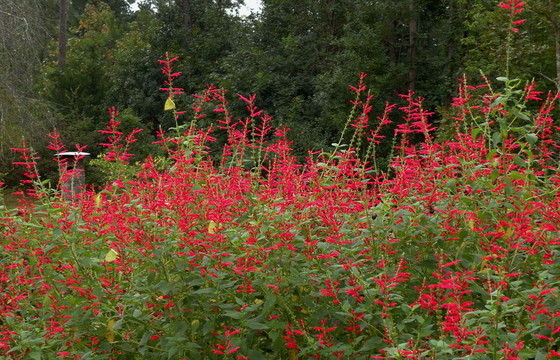 Pineapple sage in bloom (Terry W. Johnson)
By TERRY W. JOHNSON
If you enjoy gardening for hummingbirds, you should become acquainted with the salvias. Salvias and hummingbirds are so mutually beneficial that wildlife gardeners sometimes call them the perfect pair.
Depending on which plant taxonomist you talk to, there are anywhere from 700 to 3,000 types of salvias. Although many of these are grown in gardens throughout Georgia, one of the favored salvias is pineapple sage (Salvia elegans).
A trait that sets this plant apart, depending on where you live in the Peach State, is its blooming period. Named for the sweet scent of it foliage, pineapple sage blooms from summer into fall and beyond.
I confess I didn’t even know pineapple sage existed until I began banding wintering hummingbirds some three decades ago. Often when I visited the homes of folks hosting winter hummers – particularly in south Georgia – I found pineapple sage plants covered with bright red, tube-shaped blossoms.
Realizing the presence of blossoms and birds was probably no coincidence, I made a point of learning more out about this showy plant. …
Read the rest of Terry’s column to discover the virtues of pineapple sage.
Terry W. Johnson is a retired DNR program manager and executive director of TERN, the Wildlife Conservation Section’s friends group. Check out past columns, his Backyard Wildlife Connection blog and his book “A Journey of Discovery: Monroe County Outdoors.” Permission is required to reprint his columns.
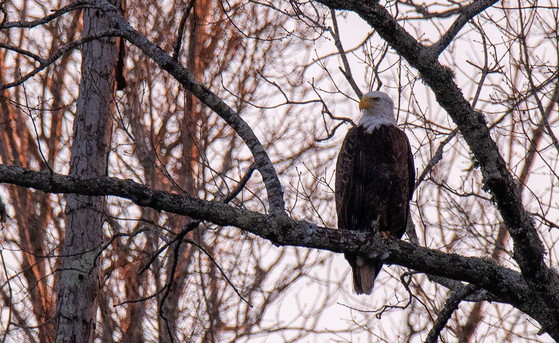 Bald eagle at rest (Anita Leming/anitalemingphotography.smugmug.com)
Bald eagle nesting is going strong in Georgia, according to initial DNR survey results. With follow-up flights set in March to document nest success, more than half of the nearly 250 known nests on the coast and in southwest Georgia had eggs, young or an incubating adult. Survey leader Dr. Bob Sargent also found 21 new nests. While normally about half the state is flown each year, all known nests are being checked this year for the first time since 2017, when Georgia set a survey high of 218 active nests.
What’s up under the gold dome? Stay in the know about wildlife and natural resource-related legislation with help from the Georgia Conservancy and the Georgia Wildlife Federation’s Camo Coalition.
In Congress, the House version of Recovering America’s Wildlife Act (H.R. 2773) – which will provide vital funding to keep animals and plants off the endangered species list – cleared the Natural Resources Committee with bipartisan support. For more: Wildlife Society profiles the bill; Georgia's proposed projects.
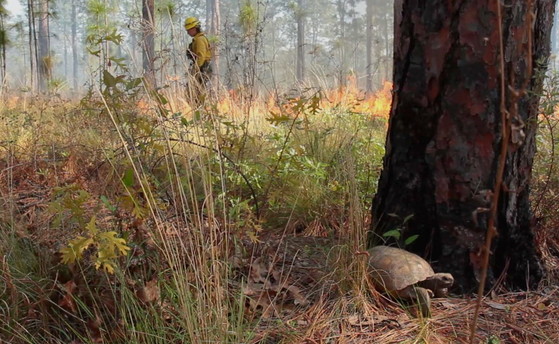 Prescribed fire is vital to restoring habitats for many species, including gopher tortoises. (Abel Klainbaum)
Prescribed fire is in season. With the habitat-healthy fires celebrated recently in Prescribed Fire Awareness Week, DNR and partners are conducting controlled burns across the state (video) and providing technical and other aid for private landowners, including a Learn and Burn workshop next week in Alapaha.
For youth who like to paint or draw, DNR offers a number of nature-focused competitions. Options include the Youth Birding T-shirt Art Contest (preK-12th grade; enter by March 15), Give Wildlife a Chance Poster Contest (grades K-5; April 8) and the Georgia Fish Art Contest (K-12; March 31).
Georgia’s mid-winter shorebird count topped 52,000 this year, from a single purple sandpiper to more than 28,000 dunlins. The annual census of island beaches is a snapshot of shorebirds that winter or stopover here, highlighting the importance of the Georgia coast, helping shape management and underscoring big-picture trends such as an increase in black-bellied plovers and a decline in sanderlings.
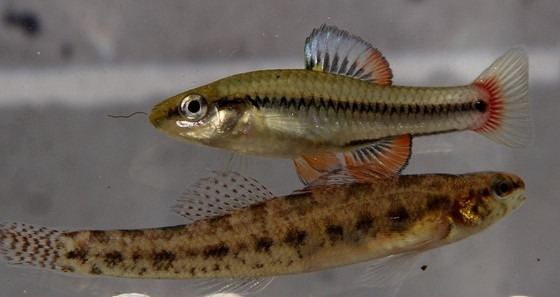 Male bluefin killifish (top) and a swamp darter from Magnolia Springs (DNR)
Sampling in the spring and below the dam at Magnolia Springs State Park near Millen turned up plenty of state-rare bluefin killifish plus three native mussel species, largemouth bass, American eel, darters and sunfish. The work last month, joined by parks staff and Georgia Southern University students, was aimed at identifying rare species that should be part of future plans to manage the spring.
Quick hits:
- When filling out your Georgia tax forms, help wildlife by contributing through the Give Wildlife a Chance checkoff, line 31 of the state's long income tax form (Form 500) and line 10 of the short form (Form 500EZ).
- Oak Grove Elementary STEM teacher Kendall Xides received the $1,000 Conservation Teacher of the Year grant from DNR and TERN for her student-centered proposal to revamp the DeKalb County school’s nature trail.
- DNR’s inaugural Career Academy July 17-23 will help up to 20 high school students explore conservation careers with the agency.
- Angler Matt McWhorter ended 2021 on a high note, landing a Georgia-record 8-pound, 5-ounce shoal bass Dec. 23 on the Chattahoochee River near Columbus.
- For a quick look at the fierce side of loggerhead shrikes (aka butcherbirds), see this not-for-the-queasy Facebook post.
Names in the news: During its annual conference, the Georgia Chapter of the American Fisheries Society named DNR fisheries biologist Sarah Baker Professional of the Year in Fisheries Management and Wildlife Conservation Section Program Manager Dr. Brett Albanese Professional of the Year in Fisheries Science and Research, installed Marion Baker of the Go Fish Education Center as president, and elected biologist Ani Escobar as president-elect. The chapter's monthly newsletter profiled DNR aquatics biologist Paula Marcinek. Biologist and author E.O. Wilson, dubbed the father of biodiversity, died Dec. 26. Also in memoriam: Ernest Koone III, whose Lazy K nursery in Pine Mountain was considered the country’s largest grower of native azaleas, passed Jan. 6.
WHAT YOU MISSED ...
In the previous Georgia Wild:
- Top wildlife headlines
- What's new with right whales
- Behind the myths of mistletoe
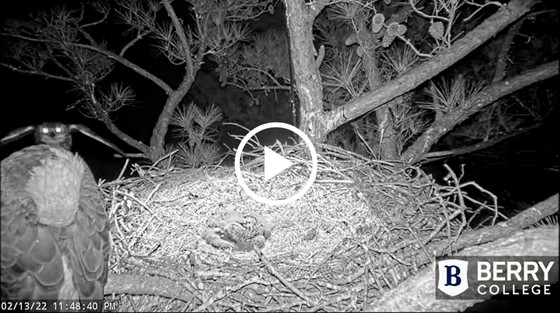 Eagles and owls: owl attacks bald eagle mom (Berry College); great horned owl wards off passing eagle (The Landings/Cornell Lab)
(audio) DNR's Shan Cammack talks prescribed fire on the National Deer Association's "Deer Season 365" podcast
(audio) DNR's Dr. Brett Albanese discusses state-endangered holiday darters on the U.S. Fish and Service "Fish of the Week" podcast
(audio) "New documentary focuses on right whales' plight," Maine Public
"Advocates appeal to boaters to protect right whales," WABE-FM (90.1, Atlanta)
Other right whale news: "Population continues downward trajectory" (North Atlantic Right Whale Consortium); "Baby whale genetic testing may help save species" (ABC News); "Maine lawmakers push for delay of whale protections" (The Hill), "NOAA clears boaters in crash that killed whale," (WJXT-TV/ch. 4, Jacksonville, Fla.); "Fla. issues cautions for boaters during calving season" (WWSB-TV/ch. 7, Sarasota, Fla.); "Feds warn it's wrong to approach whales" (Yahoo!news)
"A win in work to save super-rare salamander," WABE-FM (90.1, Atlanta)
"Atlanta educator awarded DNR Conservation Teacher grant," AllonGeorgia
"Bridled darters: What a tiny fish can tell about river health," WTVC-TV (ch. 9, Chattanooga, Tenn.)
"Acquisition more than doubles size of Ocmulgee Mounds," National Park Service. Also: The Washington Post.
"Tracking the life cycle of Georgia's striped newts," UGA
"Land purchase for Camden spaceport delayed for special election," Atlanta Journal-Constitution
"Roads are killing wildlife; infrastructure law aims to help," Georgia Public Broadcasting
"Wildlife corridors: from divide, conquer to connect, restore," Georgia Straight
"Carpet of flowers blooming at Wolf Creek Preserve," Tallahassee Democrat
"Healthy Beaches launches improved swim advisory map," The Brunswick News
"Community mourns death of bird ambassador Sibley," Georgia Public Broadcasting
"Proposed Tennessee refuge in sight," U.S. Fish and Wildlife Service
Top
|